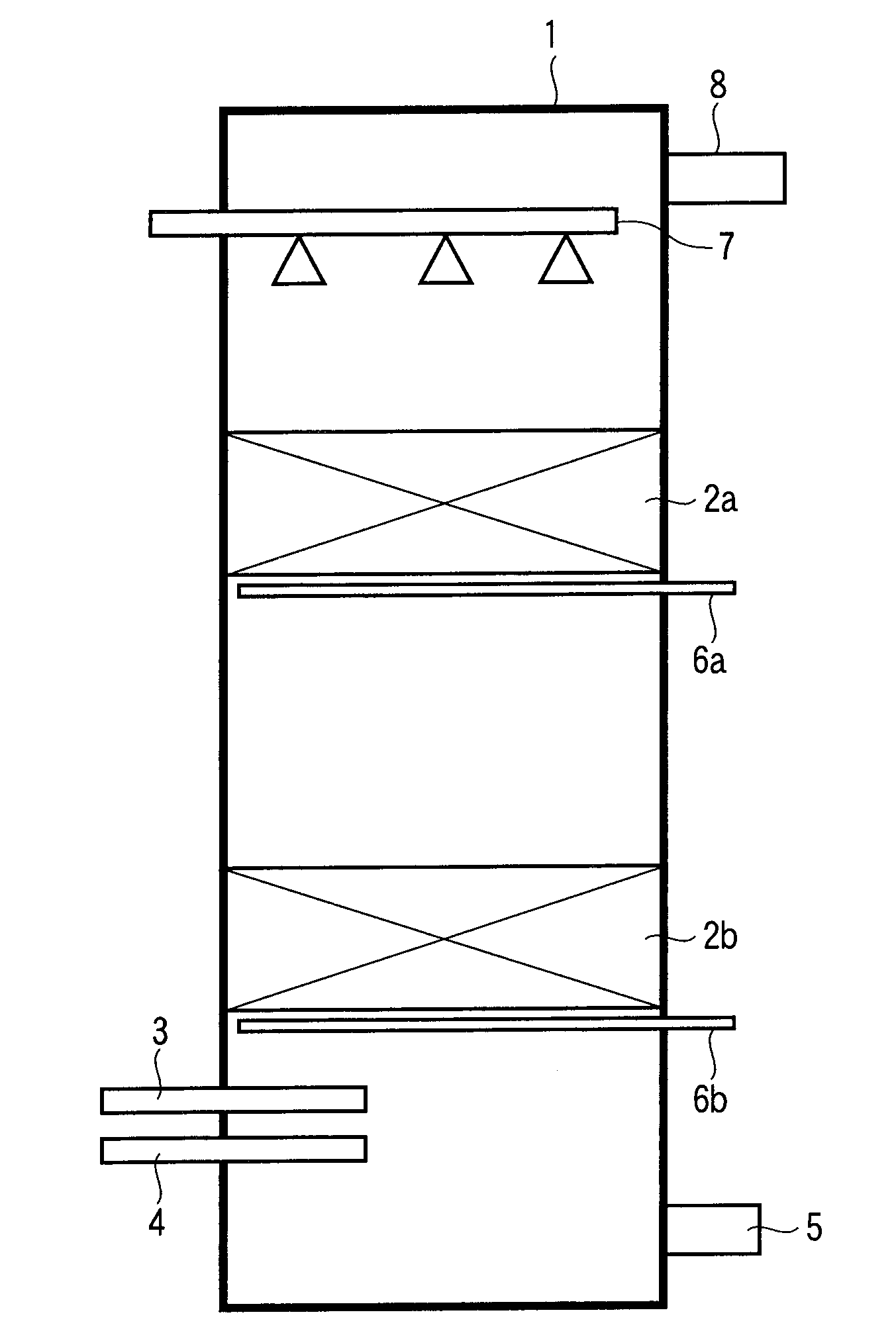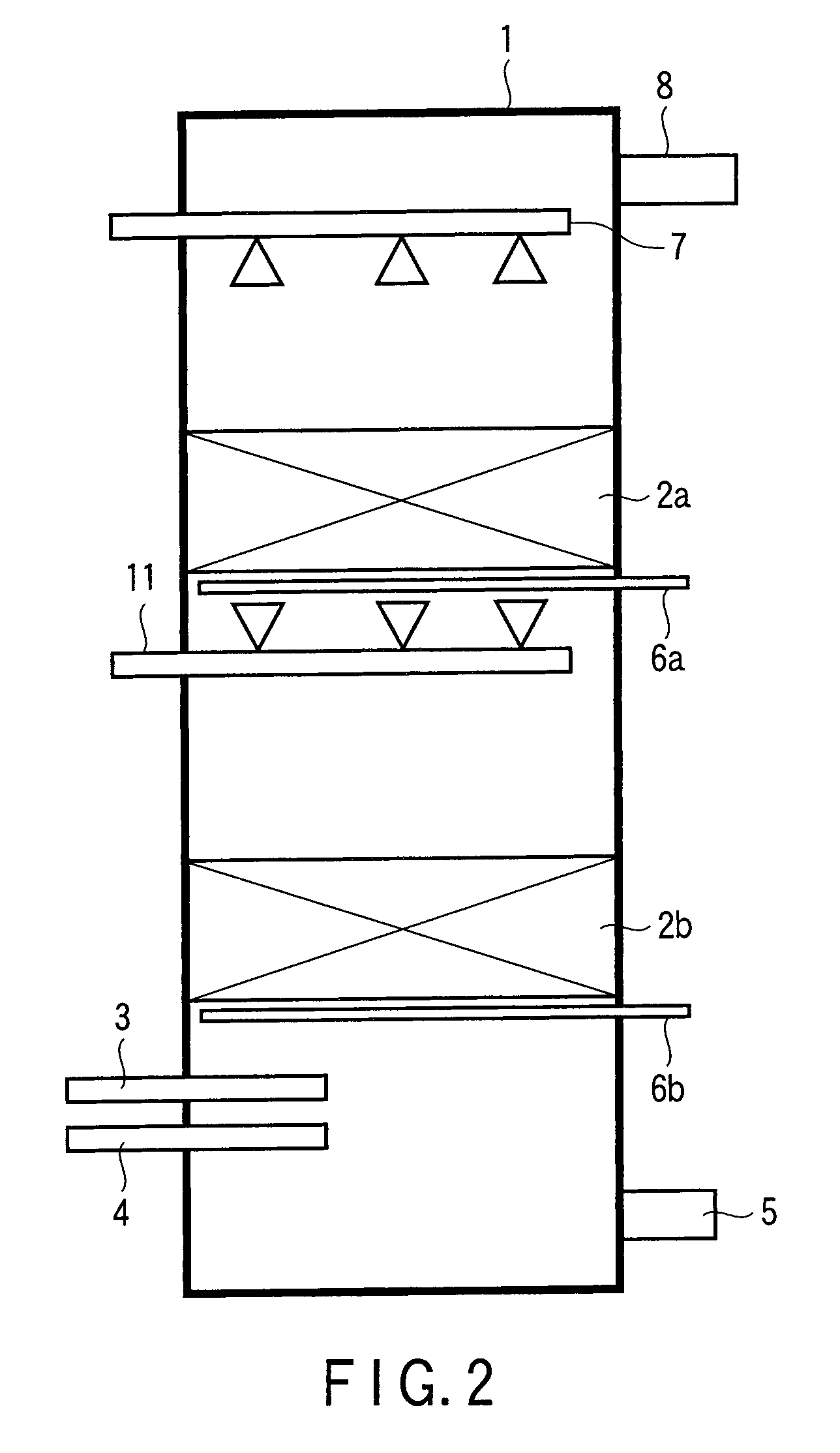Biological desulfurization apparatus
a technology of desulfurization apparatus and desulfurization chamber, which is applied in the direction of gaseous fuels, biomass after-treatment, separation processes, etc., can solve the problems of corroding facilities, easy clogging of the packed layer with microorganisms, and rocketing running costs, and achieves stable treatment
- Summary
- Abstract
- Description
- Claims
- Application Information
AI Technical Summary
Benefits of technology
Problems solved by technology
Method used
Image
Examples
example 1
[0056]For the biological desulfurization apparatus for biogas in Example 1, FIG. 1 is referred to. Numeral 1 in the figure is a reaction tower (biological reaction tank) into which biogas generated by anaerobically fermenting organic waste is introduced. Upper-stage packed layer 2a and lower-stage packed layer 2b provided respectively with a carrier to which microorganisms had adhered are arranged vertically in the reaction tower 1. The diameter of the carrier constituting the lower-stage packed layer 2b is set greater than the diameter of the carrier constituting the upper-stage packed layer 2a. An air feeding pipe for feeding air (air feeder) 3, a biogas feeding pipe 4 for feeding biogas to the reaction tower 1, and a drain tube 5 for discharging water supplied to the reaction tower 1 are arranged respectively below the lower-stage packed layer 2b in the reaction tower 1. Washing air pipes 6a and 6b are arranged below the upper-stage packed layer 2a and lower-stage packed layer 2b...
example 2
[0061]For the biological desulfurization apparatus for biogas in Example 2, FIG. 2 is referred to. The same members as in FIG. 1 are assigned like numerals to omit their description, and the main part only is described.
[0062]Numeral 11 in the figure is an intermediate sprinkling mechanism (sprinkling nozzle) arranged to face upward in the reaction tower 1 between the upper-stage packed layer 2a and lower-stage packed layer 2b.
[0063]In the biological desulfurization apparatus for biogas in FIG. 2, it is possible to feed water not only from the sprinkling mechanism 7 arranged in an upper part of the reaction tower 1, but also from the intermediate sprinkling mechanism 11. As described in Example 1, hydrogen sulfide gas contained in biogas flowing from the biogas feeding pipe 4 in the lower part of the reaction tower 1 is oxidized by microorganisms adhering to the surfaces of the upper-stage packed layer 2a and lower-stage packed layer 2b and thereby precipitated as a sulfur component...
example 3
[0068]For the biological desulfurization apparatus for biogas in Example 3, FIG. 3 is referred to. The same members as in FIGS. 1 and 2 are assigned like numerals to omit their description, and the main part only is described.
[0069]Numeral 12 in the figure is an intermediate air feeding pipe (hollow air feeder) for feeding air arranged between the upper-stage packed layer 2a and lower-stage packed layer 2b.
[0070]In the biological desulfurization apparatus for biogas in FIG. 3, it is possible to feed air not only from an air feeding pipe 3 arranged in the lower part of the reaction tower 1, but also from the intermediate air feeding pipe 12. The microorganisms that have adhered to the surface of the carrier in the upper-stage packed layer 2a and lower-stage packed layer 2b require oxygen for their growth because they are aerobic, sulfur-oxidizing bacteria of the genus Thiobacillus. When the air feeding pipe 3 is present at only the same site as in the biogas inflow portion and the c...
PUM
| Property | Measurement | Unit |
|---|---|---|
| time | aaaaa | aaaaa |
| diameter | aaaaa | aaaaa |
| frequency | aaaaa | aaaaa |
Abstract
Description
Claims
Application Information
 Login to View More
Login to View More - R&D
- Intellectual Property
- Life Sciences
- Materials
- Tech Scout
- Unparalleled Data Quality
- Higher Quality Content
- 60% Fewer Hallucinations
Browse by: Latest US Patents, China's latest patents, Technical Efficacy Thesaurus, Application Domain, Technology Topic, Popular Technical Reports.
© 2025 PatSnap. All rights reserved.Legal|Privacy policy|Modern Slavery Act Transparency Statement|Sitemap|About US| Contact US: help@patsnap.com



